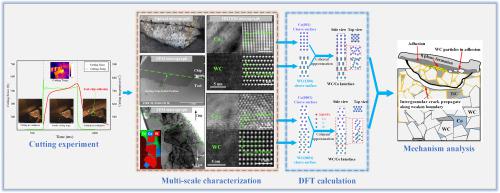International Journal of Refractory Metals & Hard Materials ( IF 4.2 ) Pub Date : 2021-04-10 , DOI: 10.1016/j.ijrmhm.2021.105549 Siyuan Gao , Minli Zheng , Jiachen Zhu , Jinguo Chen

|
Considering the frequent occurrence of adhesion failure of the cemented carbide tool during interrupted cutting of heavy parts, resulting in the sudden failure of the tool when it is far from reaching its design life. The mechanisms of adhesion failure were investigated. Adhesion failure tests were performed with an interrupted cutting operation. The microstructure of the tool-chip adhesion interface and its adjacent region were characterized using scanning electron microscopy and spherical aberration-corrected transmission electron microscopy. The phase boundaries (PBs) strength of WC/Co interfaces strength in cemented carbide tool after cutting tests were evaluated by ab-initio calculations. The results indicate that at the WC/Co interfaces of the tool-chip interface adjacent region, Co binder phase with the hcp crystal structure is detected and is accompanied by the segregation of impurities, such as Fe and Cr. Based on results from high-resolution transmission electron microscopy, approximation models of the WC/Coα and WC/Coβ interfaces were constructed. The interface strength and stability for WC/Coβ are considerably lower than those of WC/Coα, and the segregated deposition of Fe in the two types of termination PBs will reduce the strength and stability of the interface. Finally, the mechanism of the tool adhesion failure is found to arise from the significantly reduced interfacial strength of the cemented carbide material in the vicinity of the tool-chips under the action of the interrupted cutting load. As the number of mechanical-thermal shock cycles increases, the cracks follow the weakened PB large-scale expansion, and large pieces of tool material leave the rake face with the movement of the chip.
中文翻译:

硬质合金刀具间断切削过程中附着力破坏的机理:实验和从头开始的角度
考虑到硬质合金刀具在中断重零件的切削过程中经常发生粘合失效,导致刀具在远未达到其设计寿命时会突然失效。研究了粘合失败的机理。粘合破坏测试是在中断切割操作的情况下进行的。使用扫描电子显微镜和球面像差校正透射电子显微镜对工具-芯片粘合界面及其邻近区域的微观结构进行了表征。通过从头算计算来评估硬质合金刀具切削试验后WC / Co界面强度的相界(PBs)强度。结果表明,在工具-芯片界面相邻区域的WC / Co界面处,检测到具有hcp晶体结构的Co粘结相,并伴有诸如Fe和Cr等杂质的偏析。基于高分辨率透射电子显微镜的结果,WC / Co的近似模型构造了α和WC / Coβ界面。的界面强度和稳定性的WC / Co β比的WC / Co的显着地降低α,和Fe中的两种类型的终止的PBS偏析沉积会降低界面的强度和稳定性。最后,发现刀具粘附失效的机理是由于在中断切削负荷的作用下,在刀具碎片附近的硬质合金材料的界面强度显着降低。随着机械热冲击循环次数的增加,裂纹会随着PB大规模扩展的减弱而减弱,并且随着切屑的移动,大块刀具材料会离开前刀面。











































 京公网安备 11010802027423号
京公网安备 11010802027423号